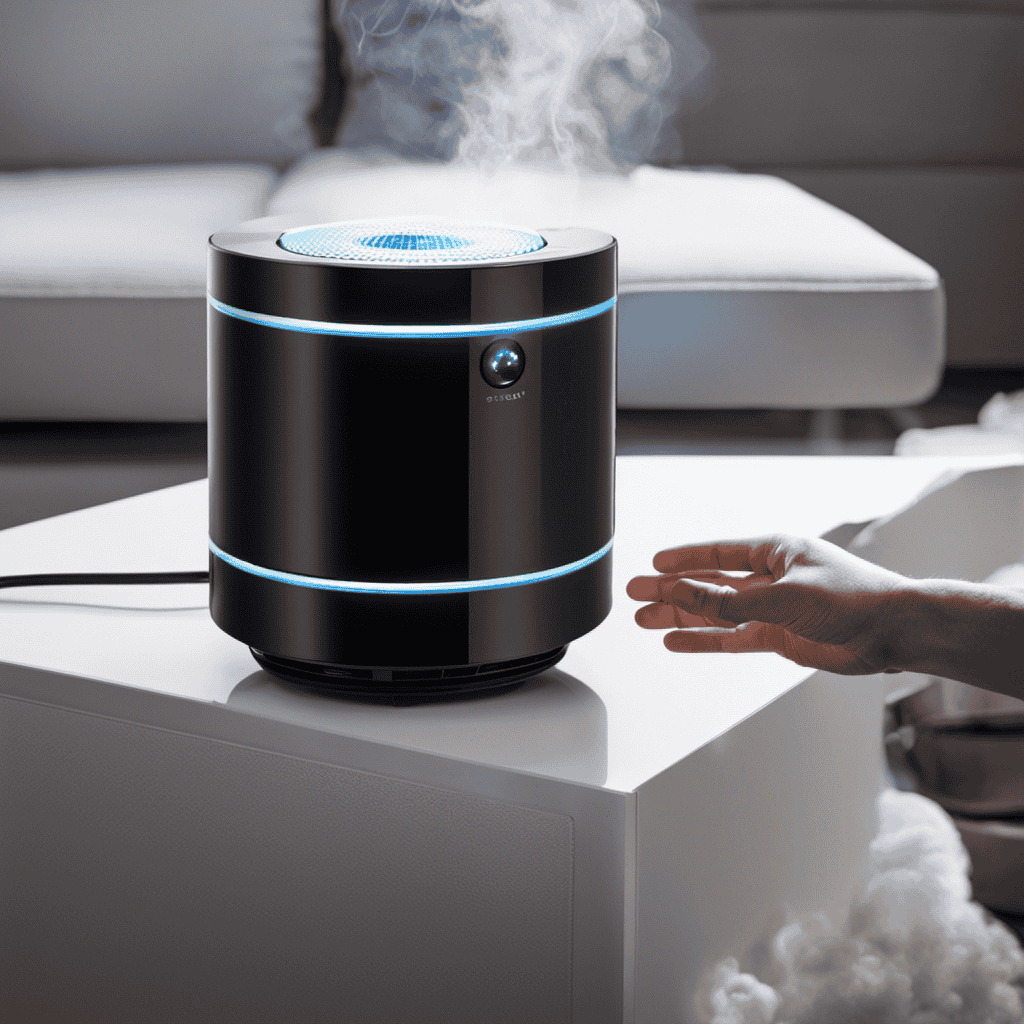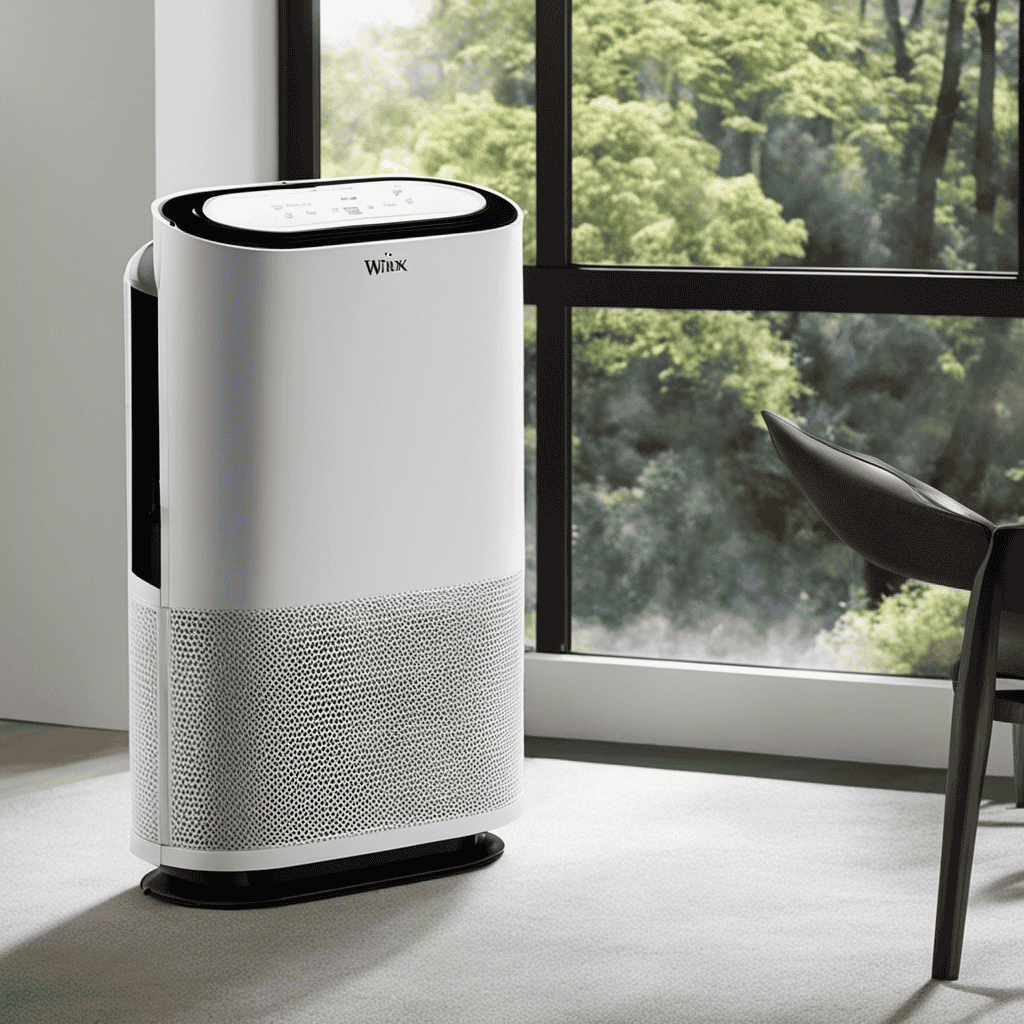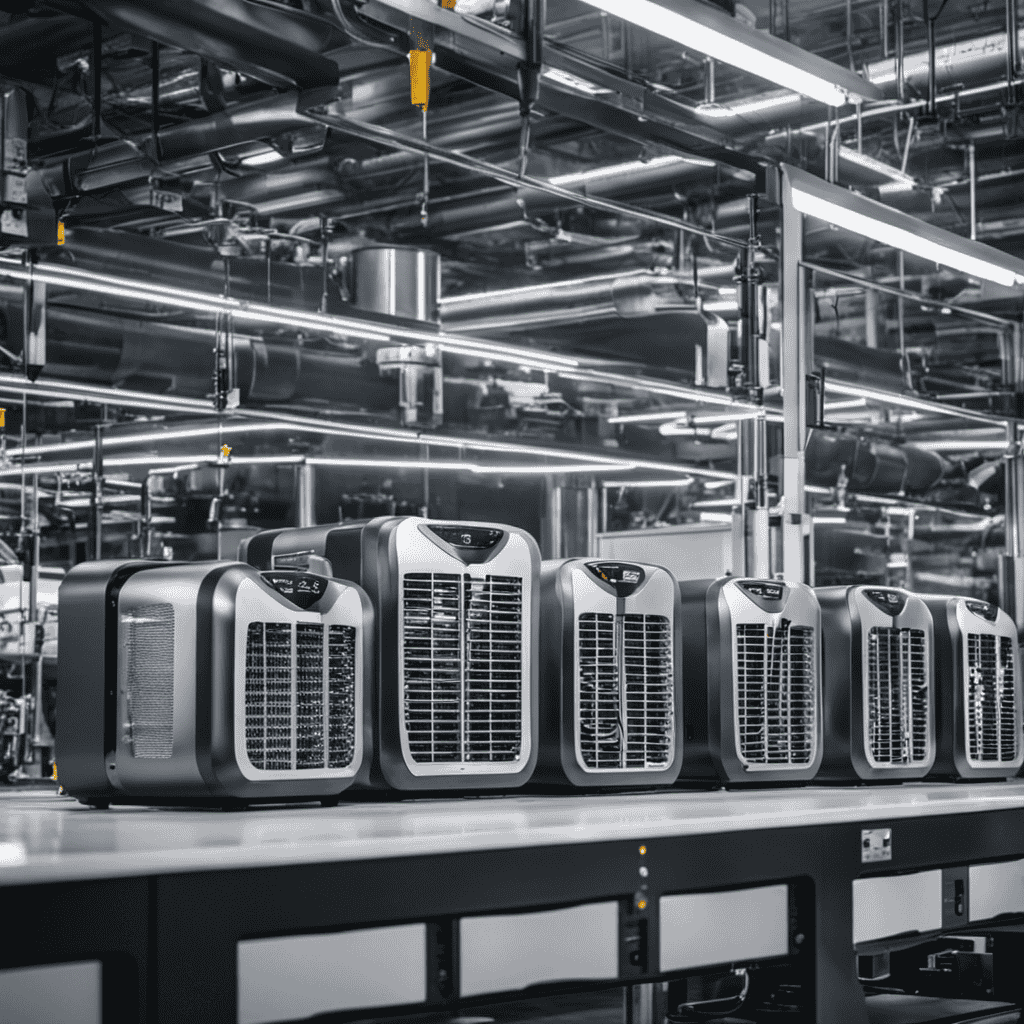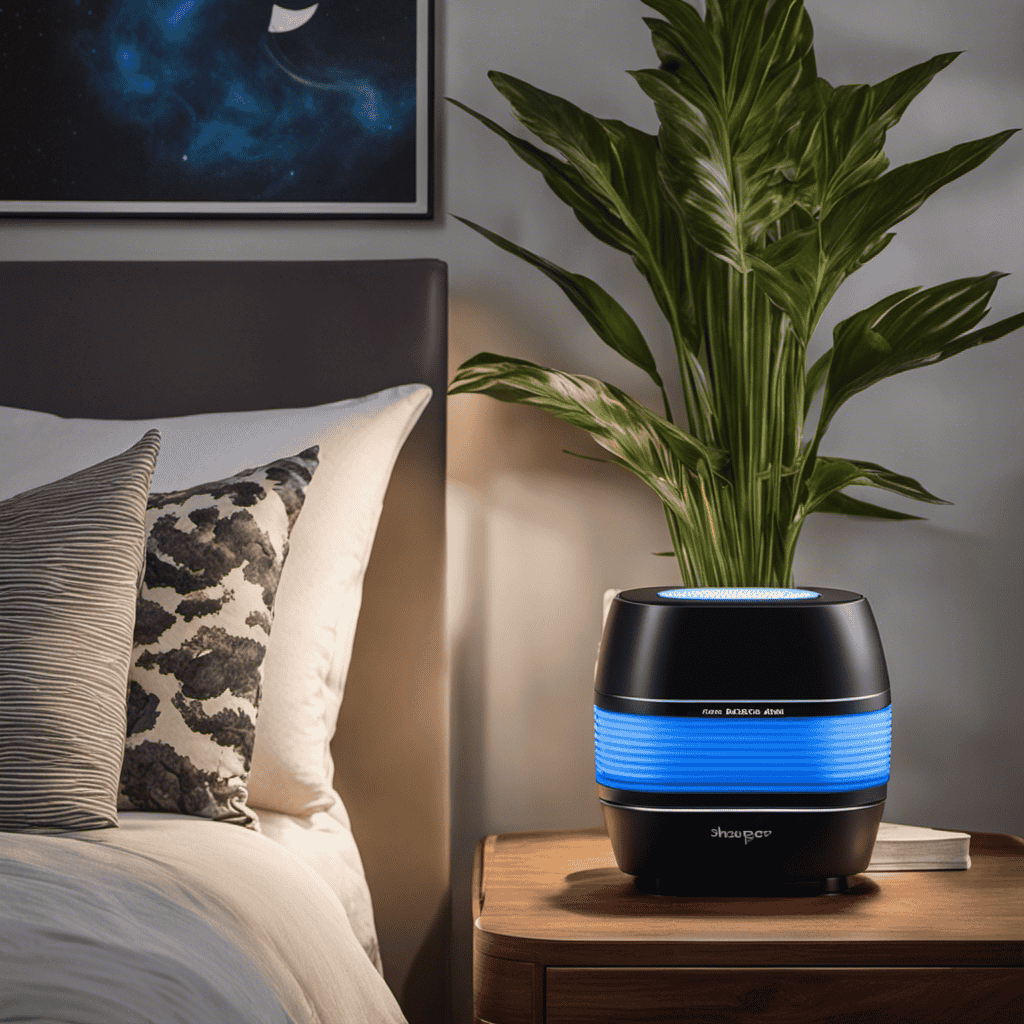When I enter my house, I breathe in the refreshing, clean air. The reason for this revitalizing environment is my reliable air purifier.
In this article, I’ll guide you through the ins and outs of using an air purifier effectively. From understanding different types of purifiers to setting up and maintaining them, we’ll cover it all.
So, let’s dive in and discover how this powerful device can transform the air we breathe.
Key Takeaways
- Choose the right type of air purifier based on your specific needs, such as HEPA filter for capturing particles, activated carbon filter for removing odors, and UV germicidal irradiation purifiers for killing bacteria and viruses.
- Consider the efficiency, cost, and maintenance requirements of different filter types before making a decision.
- Take into account the size of the room when selecting an air purifier, ensuring that it has a higher Clean Air Delivery Rate (CADR) for larger rooms.
- Proper placement and positioning of the air purifier is important for optimal performance, including placing it in a central location, keeping it away from walls or furniture, and ensuring proper airflow direction.
Types of Air Purifiers
So, when it comes to choosing an air purifier, you should consider the different types available.
Air purifiers are essential for maintaining clean indoor air quality and provide numerous benefits.
There are several types of air purifiers to choose from, each with its own unique features and benefits.
The first type is a HEPA (High-Efficiency Particulate Air) filter purifier, which effectively captures 99.97% of particles as small as 0.3 microns.
Another type is an activated carbon filter purifier, which removes odors, gases, and chemicals from the air.
UV germicidal irradiation purifiers use ultraviolet light to kill bacteria and viruses, while ionizers release negatively charged ions to neutralize pollutants.
It is important to regularly clean and maintain your air purifier to ensure optimal performance and longevity.
Now that we know about the different types of air purifiers, let’s move on to choosing the right one for your needs.
Choosing the Right Air Purifier
When it comes to choosing the right air purifier for your home, there are two key factors to consider: filter type comparison and room size considerations.
Filter type comparison is important because different filters target different types of pollutants, such as dust, pet dander, or allergens.
Room size considerations are also crucial as the size of the room will determine the air purifier’s effectiveness in cleaning the air.
Therefore, understanding these two aspects will help you make an informed decision and ensure that you select the most suitable air purifier for your specific needs.
Filter Type Comparison
To compare filter types for your air purifier, you’ll want to consider factors such as efficiency, cost, and maintenance.
When it comes to air purifier efficiency, HEPA filters are considered the gold standard. These filters are capable of trapping up to 99.97% of particles as small as 0.3 microns. They are highly effective in removing common allergens like dust mites, pollen, and pet dander from the air.
On the other hand, activated carbon filters are great for removing odors and harmful gases. However, they are not as efficient in capturing smaller particles.
When it comes to filter replacement frequency, it depends on the air quality and usage. Generally, HEPA filters should be replaced every 6-12 months, while activated carbon filters may need replacement every 3-6 months.
Consider these factors when choosing the right filter type for your air purifier.
Room Size Considerations
If you have a larger room, you may want to consider using an air purifier with a higher Clean Air Delivery Rate (CADR) to ensure proper air circulation and purification. When selecting an air purifier for a larger space, there are a few room layout considerations to keep in mind.
Here are some factors to consider:
-
Size of the room: Determine the square footage of the room to match it with the appropriate CADR rating.
-
Airflow direction: Ensure that the air purifier is placed in a location where it can effectively circulate clean air throughout the entire room.
-
Obstructions: Avoid placing the air purifier near furniture, curtains, or other objects that may obstruct the airflow.
-
Noise level: Consider the noise level of the air purifier, especially if you plan to use it in a bedroom or office.
-
Maintenance requirements: Regularly clean or replace the filters to maintain optimal performance.
Considering these factors will help you select the right air purifier for your larger room and ensure that it effectively improves the air quality in your space.
Placement and Positioning
Make sure you place the air purifier in a central location within the room. Proper placement is essential for the efficient functioning of an air purifier.
First, consider the size of the room. For optimal performance, it’s recommended to place the purifier in a room where the air circulates freely, such as the center of the room. This allows the purifier to clean the air evenly in all directions.
Additionally, keep the purifier at least a foot away from walls or furniture to ensure unrestricted airflow. Proper positioning not only improves the purifier’s effectiveness in removing pollutants but also enhances the air quality throughout the entire room.
Setting up the Air Purifier
Setting up the purifier is straightforward and can be done in just a few simple steps.
First, find a suitable location for your air purifier that complements your room decor.
Next, remove the packaging and plug in the device. Ensure that the power switch is turned off before connecting the power cord.
Once the purifier is powered on, you can adjust the settings according to your preferences.
Finally, don’t forget to regularly clean and replace the filters to maintain optimal performance.
Using an air purifier has many benefits.
It helps to remove airborne particles such as dust, pollen, and pet dander, improving the air quality in your home.
This can be especially beneficial for individuals with allergies or respiratory conditions.
Additionally, air purifiers can reduce odors and eliminate harmful pollutants like smoke and VOCs.
With a properly set up air purifier, you can enjoy cleaner and fresher air while enhancing your room decor.
Adjusting the Fan Speed
When it comes to adjusting the fan speed of an air purifier, there are several key considerations to keep in mind.
Firstly, finding the optimal fan speed is crucial in order to achieve maximum air purification efficiency.
Secondly, noise level considerations play a significant role, especially for those who prefer a quieter environment.
Lastly, energy efficiency concerns are important to address, as running the air purifier at a higher fan speed may consume more energy.
Optimal Fan Speed
To get the most out of your air purifier, you’ll want to adjust the fan speed to the optimal level for your specific needs. Fan speed control plays a crucial role in air purification efficiency.
Here are some key points to consider:
-
Size of the room: Adjust the fan speed based on the size of the room. A larger room may require a higher fan speed to effectively circulate the air.
-
Air quality: If the air quality is poor or there are strong odors, increasing the fan speed can help remove contaminants more quickly.
-
Noise level: Higher fan speeds can generate more noise. Consider your comfort and tolerance for noise when adjusting the speed.
-
Energy consumption: Higher fan speeds consume more energy. If energy efficiency is a concern, you may want to keep the speed lower.
-
Personal preference: Ultimately, finding the optimal fan speed is a matter of personal preference. Experiment with different speeds to find the balance between air purification and comfort.
Noise Level Considerations
When considering noise level in an air purifier, it is important to prioritize silent operation, especially during nighttime use or in quiet environments. Thankfully, many modern air purifiers are designed with sleep mode, which ensures a quieter operation.
Sleep mode typically reduces the fan speed and minimizes any beeping sounds, allowing for a more peaceful environment conducive to sleep. This mode is ideal for bedrooms or offices where you require a serene atmosphere.
Some air purifiers even have a timer function, which allows you to set the device to automatically enter sleep mode after a certain period of time. Additionally, look for air purifiers with noise reduction technology or sound dampening features to further minimize any operational noise.
Energy Efficiency Concerns
Consider looking for air purifiers that have an energy-saving mode to help you reduce your electricity consumption. Energy efficiency is an important consideration when using an air purifier, not only to save on utility bills but also to minimize the environmental impact.
Here are some energy-efficient features to look for:
-
Energy-saving mode: This mode adjusts the fan speed and power consumption based on the air quality, reducing energy usage.
-
Timer function: Set the purifier to operate only when needed, saving energy when you’re not at home or during the night.
-
Auto mode: The purifier automatically adjusts its settings based on the air quality, optimizing energy consumption.
-
Sleep mode: This mode operates the purifier at a lower fan speed and noise level, conserving energy while you sleep.
-
Energy Star certified: Look for air purifiers with the Energy Star label, indicating that they meet strict energy efficiency guidelines.
Understanding Filters
Understanding filters is important because they help to trap and remove harmful particles from the air in your home. Filter maintenance is crucial to ensure that your air purifier functions effectively.
Regularly cleaning or replacing the filter is essential for optimal performance. Filters can become clogged with dust, pollen, pet dander, and other airborne contaminants over time. If not properly maintained, these particles can hinder the filter’s ability to capture pollutants, reducing its efficiency.
To maintain the filter, it is recommended to follow the manufacturer’s instructions. Some filters can be vacuumed or rinsed, while others may need to be replaced entirely. It is important to check the filter regularly and replace it when it becomes visibly dirty or according to the manufacturer’s recommended schedule.
Proper filter maintenance is vital for ensuring that your air purifier continues to provide clean and healthy air in your home.
Cleaning and Maintaining the Air Purifier
Regularly cleaning and maintaining your air purifier is essential for optimal performance and to ensure that it continues to provide clean and healthy air in your home.
Here are some cleaning instructions and maintenance tips to keep your air purifier functioning effectively:
- Start by turning off and unplugging the unit.
- Remove the filters and gently vacuum or brush away any dust or debris.
- If the filters are washable, rinse them with warm water and mild soap, then allow them to air dry completely before reinserting.
- Wipe down the exterior of the purifier with a damp cloth to remove any dirt or fingerprints.
- Check the manufacturer’s instructions for recommended filter replacement intervals and schedule regular filter changes accordingly.
Monitoring Air Quality
Regular monitoring of air quality is of utmost importance in ensuring a healthy and safe environment. By regularly assessing the air quality, one can identify potential pollutants and take necessary actions to improve it.
In addition, understanding the effectiveness of different air purification methods is crucial in selecting the most appropriate solution for your specific needs.
Importance of Regular Monitoring
It’s crucial to regularly monitor the air quality in your home when using an air purifier. By doing so, you can ensure that the air purifier is functioning properly and effectively removing pollutants from your indoor environment. Regular monitoring allows you to identify any changes or fluctuations in air quality, which may indicate the need for maintenance or filter replacement. Here are some reasons why regular monitoring is important:
- Ensures optimal performance of the air purifier.
- Helps maintain a healthy indoor environment.
- Prevents the accumulation of pollutants in your home.
- Extends the lifespan of the air purifier.
- Saves you money by avoiding unnecessary repairs or replacements.
To effectively monitor air quality, you can use air quality monitors or rely on your air purifier’s built-in sensors, if available. Remember, regular maintenance and filter replacement play a vital role in maximizing the efficiency of your air purifier and maintaining clean indoor air.
Effective Air Purification Methods
Using effective methods is key to ensuring that your indoor air is clean and free from pollutants. One of the most important aspects of maintaining an air purifier is regular maintenance. This includes cleaning or replacing filters, checking the fan and motor, and ensuring proper ventilation. Regular maintenance not only improves the performance of the air purifier but also prolongs its lifespan.
Using Additional Features and Modes
To get the most out of your air purifier, try utilizing the various additional features and modes available. Here are some tips to help you maximize the benefits of your air purifier:
- Auto Mode: This mode allows the purifier to automatically adjust its fan speed based on the air quality in the room.
- Sleep Mode: By activating this mode, the purifier operates silently and dims its display lights, ensuring a peaceful sleep environment.
- Timer Function: Set a timer to automatically turn on or off the purifier at specific times, saving energy and ensuring optimal usage.
- Filter Replacement Indicator: Keep an eye on the indicator to know when it’s time to replace the filters, ensuring efficient air purification.
- Air Quality Monitor: Some purifiers have built-in sensors that detect the air quality and display it, helping you monitor and maintain clean air in your space.
Troubleshooting and Common Issues
If your air purifier isn’t working properly, try troubleshooting common issues to identify and resolve the problem.
Air purifiers are designed to improve indoor air quality by removing pollutants from the air. However, like any electronic device, they can encounter problems.
One common issue is a decrease in airflow. This could be caused by a clogged air filter, which should be cleaned or replaced regularly.
Another problem is a malfunctioning fan, which may need to be repaired or replaced.
Additionally, if your air purifier is emitting strange odors, it could be a sign of a dirty or worn-out filter. Cleaning or replacing the filter should solve the issue.
Frequently Asked Questions
How Long Does an Air Purifier Typically Last Before Needing to Be Replaced?
An air purifier typically lasts for several years before needing to be replaced. Factors such as usage, filter quality, and maintenance can affect its lifespan. It is important to monitor the air purifier’s performance and replace it when it no longer effectively filters the air.
Can I Leave the Air Purifier on All Day, Even When I Am Not at Home?
Yes, you can leave the air purifier on all day, even when you’re not at home. However, it’s important to consider air purifier maintenance and the energy consumption of air purifiers to ensure efficiency and safety.
Is It Safe to Use an Air Purifier in a Room Where a Baby or Young Child Sleeps?
Yes, it is safe to use an air purifier in a room where a baby or young child sleeps. Regular air purifier maintenance ensures optimal performance and the benefits of using an air purifier include cleaner air and reduced allergens.
Can an Air Purifier Help With Allergies Caused by Pet Dander?
An air purifier can help alleviate allergies caused by pet dander by filtering out the allergens from the air. Regular air purifier maintenance ensures optimal performance and maximizes the benefits of using an air purifier.
Will an Air Purifier Remove Odors From Cooking or Smoking?
Using an air purifier can effectively remove odors from cooking or smoking. The maintenance of the air purifier is crucial for its long-term effectiveness in eliminating these odors and improving indoor air quality.
Can I Use an Air Purifier to Eliminate Specific Allergens?
Yes, specific air purifier operation principles target allergens like pet dander, dust mites, and pollen. HEPA filters and activated carbon are used to capture and neutralize these particles. Additionally, some air purifiers utilize UV-C light to eliminate mold spores and bacteria.
Can Changing the Wind Direction of an Air Purifier Affect Its Effectiveness?
Yes, the direct air purifier wind direction can significantly affect its effectiveness. If the purifier is not positioned correctly, the clean air may not reach the entire room. It’s important to ensure that the airflow is directed towards the center of the room for optimal purification.
Conclusion
After following these steps, I can confidently say that using an air purifier has greatly improved the air quality in my home. It’s amazing how something as simple as an air purifier can make such a big difference in our health and well-being.
As the saying goes, ‘Clean air is like a fresh start every day.’ So why not invest in an air purifier and experience the benefits for yourself?
Remember to choose the right type, set it up correctly, and maintain it regularly for optimal results. Breathe easy and enjoy the clean, fresh air!










